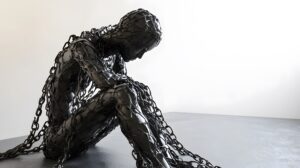Luigi Mangione’s transformation from a promising academic star to an alleged murderer encapsulates the interplay of evolutionary instincts, physical struggles, and societal pressures. His story is cautionary, revealing the deeper mechanisms of stress and anger rooted in human survival instincts and their misalignment with modern life.
The Evolutionary Roots of Stress and Anger
Early humans relied on the fight-or-flight response to survive life-threatening dangers like predators or famine. This response prioritizes immediate survival, redirects energy to muscles, and increases awareness, enabling quick reactions. While the threats of the past were physical, modern stressors—missed deadlines, rejection, or failure—trigger the exact survival mechanisms.

The inability of the brain to distinguish between physical and emotional threats leads to misdirected reactions.1 For Mangione, this manifested in anxiety escalating into anger, an emotion designed to provide temporary control but often misapplied in today’s context. This misalignment between ancient instincts and modern stressors is a central theme in understanding his decline.
Promising Beginnings
Mangione was raised in a prominent Baltimore family known for its philanthropy. His early life reflected immense potential: valedictorian of high school earned both a bachelor’s and a master’s degree in computer science from the University of Pennsylvania in just four years. Creative and driven, he founded a video game programming club and excelled at his first job with TrueCar. However, the isolation of the COVID-19 pandemic disrupted his promising trajectory, sowing the seeds of his unraveling.
The Gradual Descent: Pain, Isolation, and Misdirected Coping
In 2022, Mangione moved to Hawaii, hoping to manage his spinal condition, spondylolisthesis, through lifestyle changes. While initially optimistic, he developed obsessive habits, meticulously planning fitness routines and immersing himself in self-help literature. A surfing accident in 2023 worsened his pain. A stable spondylolisthesis is not considered a source of pain, and surgery is usually ineffective. He had surgery anyway, and it predictably did not provide the relief he sought, deepening his emotional pain and isolation.
Emotional pain, unlike physical pain, can feel inescapable and drive individuals toward destructive coping mechanisms. For Mangione, the obsessive quest to conquer his pain led to the abandonment of support networks and a turn toward “manosphere” ideologies. While these offered temporary relief, they also reinforced his sense of alienation.
The Neurological Impact of Stress and Anger
Stress fundamentally alters brain function, redirecting energy from the prefrontal cortex—the seat of reasoning and decision-making—to survival-oriented brain regions. This explains Mangione’s escalating misdirected coping mechanisms. In such states, anger provides a fleeting sense of power but worsens underlying struggles.
Research into stress and bullying mirrors this dynamic. Bullies often act out of unresolved anxiety, using aggression to regain control, while their victims experience heightened stress responses and long-term emotional damage. This pattern is reflected in Mangione’s obsessive behaviors and isolation, where unresolved stress and pain perpetuated his withdrawal and emotional turmoil.2
The Breaking Point: Mangione’s Arrest
By June 2024, Mangione had cut off contact with his social circle. Months later, he was arrested for the predawn shooting of UnitedHealthcare CEO Brian Thompson outside a Manhattan hotel. The crime marked the culmination of his years-long descent into despair. At his arraignment, Mangione appeared disheveled, shouting about injustice—a stark contrast to the composed, ambitious young man he once was.
The Threat Perception Problem
Mangione’s story highlights how the brain misinterprets modern stressors. Unlike other mammals, humans process social and mental threats—such as rejection or failure—through the same pathways as physical threats. Anxiety, the body’s alarm system, becomes overwhelming when solutions seem unattainable, escalating into anger. This survival mechanism, intended to protect, often results in destructive outcomes, as evidenced by Mangione’s case.
The Cycle of Stress and Anger
Mangione’s struggles align with broader patterns of stress-induced behavior. Consider a bullied child: the bully’s aggression stems from anxiety and insecurity, while the victim’s stress mirrors the response to a predator. This dynamic persists into adulthood, shaping relationships and behaviors. Long-term studies on bullying show that victims often face heightened rates of anxiety, depression, and career struggles later in life.3
Mangione’s trajectory reflects these findings. His pain and isolation, compounded by unresolved emotional issues, drove him toward coping mechanisms that ultimately failed to address his underlying struggles. His social media activity in his final months reflected a shift toward darker worldviews, signaling increasing frustration and despair.
The Business of Medicine: A Systemic Failure
Mangione’s physical struggles also reflect systemic healthcare failures. Chronic pain patients often endure ineffective treatments motivated by profit rather than genuine healing. Dr. Ian Harris, in Surgery: The Ultimate Placebo, critiques the prevalence of unproven medical interventions, highlighting how they trap patients in cycles of false hope and disappointment.4
The healthcare system frequently overlooks effective, low-cost treatments like mindfulness-based stress reduction and expressive writing. These methods, proven to alleviate pain and improve well-being, must be utilized due to their need for more profitability. Mangione’s intense focus on self-help and fitness routines underscores a desperate attempt to fill the gaps left by a system that failed him.

A Life of Contrasts
Mangione’s story is one of stark contrasts: a promising academic and professional trajectory versus an isolated individual consumed by pain and anger. His achievements revealed his potential, but his decline highlights the dangers of untreated psychological struggles and societal neglect. Despite his intellect and resources, he could not navigate the complex interplay of physical, emotional, and societal challenges.
Lessons from Mangione’s Decline
The rise and fall of Luigi Mangione underscore the need for systemic reforms in healthcare and mental health support. His story reflects how the misfiring of evolutionary survival mechanisms can escalate anxiety and anger into destructive behaviors when faced with modern challenges. Addressing these issues requires balancing the strengths and vulnerabilities of human nature to prevent similar tragedies.
Mangione’s case highlights the broader failures of society to support individuals grappling with chronic pain and emotional isolation. While his alleged crime shocked those who once admired him, it also serves as a reminder of the importance of addressing the root causes of stress, despair, and alienation to ensure that others do not fall through the cracks.
References
- Eisenberger N. “The neural bases of social pain: Evidence for shared representations with physical pain.” Psychosom Med (2012); 74: 126-135.
- Copeland W, et al.” Childhood bullying involvement predicts low-grade systemic inflammation into adulthood.” PNAS (2014); 111: 7570-7575.
- Takizawa, R., Danese, A., Maughan, B., & Arseneault, L. (2015). Bullying victimization in childhood predicts inflammation and obesity at mid-life: a five-decade birth cohort study. Psychological Medicine, 45(13), 2705- 2715. https://doi.org/10.1017/S0033291715000653
- Harris, Ian. Surgery, The Ultimate Placebo. New South Publishing, Sydney, Australia, 2016.
